A fascinating look at grape varieties and wine regions
from around the world, from the vineyards and wine cellars of Ancient
Egypt, Greece and Rome to the old and new worlds of wine today.
A highlight is exquisite coloured illustrations of grape varieties
from 19th century French resources.
Research and text by Rosemary Radden
The vine
The vine (Vitis vinifera, Linn.), a plant belonging
to the Ampelidaceae family has as distinctive characteristics,
a five-toothed calyx, five petals, often attached at the top
and detaching like a cap, five stamens and a monocular berry.
The following parts make up the principal organs:
Root, stem and leaf structure of the vine

Key to the diagram.
- Germination of a seed, enlarged, its embryonic root, stem,
cotyledons and bud.
- The embryonic bud alone, at the four-leaf stage of development.
- Adventitious roots, originating particularly from swellings
of the stem or portion of the stem kept in a damp and dark
environment.
- Internode.
- Part of the bud stem in its first stage of development.
- The same showing gradual development of the bud.
- Ibid.
- Ibid.
- Young branch with alternate stipulated leaves.
- The same, at a later stage of development; alternate stipulated
leaves; towards the top, nascent clusters and tendrils.
- Detached stipule.
- Internode of a branch.
- Leaf, stipules, petiole and lobed blade with palmate venation.
- Part of a young cluster.
- Tendril emergingresulting from the other part of the same
aborted cluster.
- Tendril emergingresulting from a completely aborted cluster.
- Portion of a leaf enlarged to show its venation.
Floral system of the vine

Key to illustrations.
- Part of a composite cluster (natural size) showing some open
flowers and some still sheathed.
- Part of the same cluster enlarged showing some bracts.
- Bud (very enlarged); below, the pedicel; above, a widening
formed by the short tube of joined sepals; higher up, the obovoid
body formed by the five petals visible by their curving edges.
- The same bud opening up; below, the pedicel; above, the short
tube of the joined, lasting and fixed sepals (completely in
this species); higher up inside, the five filaments surmounted
by their anthers; above the latter, the five petals detached
from their base, still visible at the top, hidden in their
lower part, which stands up by twisting upwards; inside at
the base of the filaments and alternate with them five nectaries
surrounding the base of the ovary; finally in the centre the
ovary.
- External view of the same petals.
- Internal view of the same petals.
- The same, upside down, reduced by half (vertical section).
- Flower, still slightly enlarged, without its petals.
- Stamen, greatly enlarged, internal view; the two carpels
closed.
- The same, the two carpels open.
- External view of the same; the filament terminating in the
middle of the dorsal face.
- The ovary (enlarged to the same degree as the stamens) having,
behind it, nectaries, filaments without anthers, sepals and
peduncle.
- Joined stigma seen from above.
- Transverse section of the ovary formed from two carpels with
reflex edges, thus forming two sections; two seeds in each
section.
- Longitudinal section of the same ovary.
- Longitudinal section of the almost ripe ovary, dorsal view;
at the top the stigma and short joined marcescent styles; below,
the carpels; the median line marking the partition of the reflex
edges, the aborted or semi-aborted seeds in one of the sections,
the endocarp established by two lines on each side of that
marking the partition, the mesocarp being in the space between
the endocarp and the outer line (the exocarp) which determines
the shape.
- Ripe ovary or fruit (natural size); part of the external
casing (exocarp) having been removed, revealing the external
tissue of the mesocarp.
- Seed enlarged, ventral face.
- The same, dorsal face.
- Longitudinal section of the same revealing the layers (exoderm,
mesoderm and endoderm), the large albumen and in the lower
part the small upright embryo.
- Seed (natural size) with its funicle
Grape varieties
The following grape varieties have been selected after consideration
of their major significance in world viticulture, their contribution
to world-renowned wines, their significance in Australia, and
their current popularity and/or increasing use in Australia.
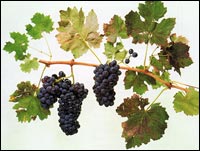 Barbera Barbera
Synonyms
None, although the variety is
often qualified by the addition
of the name of the region, as
in Barbera d’Alba, Barbera
d’Asti, Barbera del Monferrato
etc. There are several variations
in the clones.
History
Barbera is the most widely grown
red wine grape of Italy, and
the variety was known to exist
in the thirteenth century. It
is believed to have originated
in Piedmont near Monferrato and
then spread through the rest
of Italy. In Australia it has
been grown since clones were
imported from the University
of California, Davis, in the
1960s.
Geographical distribution
Barbera is to be found mostly
in Italy especially in the region
of Piedmont though it is also
to be found in Central and Southern
Italy. There are significant
plantings in California especially
in the Central and Napa Valleys
and it is also to be found in
Argentina, Brazil, Dalmatia and
Uruaguay. There are only small
plantings as yet in Australia,
though it has been grown for
approximately 25 years in the
Mudgee region of New South Wales,
with later plantings in the King
Valley and the Mornington Peninsula
in Victoria.
Characteristics
Vine
The vine is fairly vigorous and high yielding particularly if grown
in a warm to hot environment with suitable soils, but it is susceptible
to several diseases. The leaves are medium in size, flat, 5-lobed
with a hairy lower surface.
Fruit
The bunches are of small to medium size and usually conical, winged
and compact. The berries are of medium size, black, oval in shape
and bear a heavy bloom. They are late ripening and generally
have soft skins.
Wine
The juice has a good colour, high levels of acid and tannin, with
a fruity, floral nose and a distinctive varietal palate. While
the wine produced is usually drunk early it will also age well.
Barbera is used in Italy to make dry red wines and also sweet
red and sparkling red wines.. There are only two DOCs for varietal
Barbera and it is more usually blended with a varying percentage
of other red varieties because of Barbera’s somewhat neutral
palate. Similar methods of wine making are used in all the regions
in which it is cultivated and therefore the same variety of styles
is presented, but it is generally most valuable as a blending
wine.
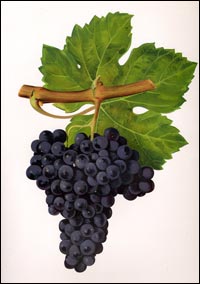 Cabernet
franc Cabernet
franc
Synonyms
None in Australia. In France
Cabernet Franc is also known
as Cabernet Gris, Grosse Vidure,
Bouchet (St. Emilion and Pomerol),
Carmenet (Médoc) and Breton
(Loire). In Italy it is also
known as Bordo (Veneto).
History
Cabernet Franc was recognised
in the Bordeaux area by the end
of the eighteenth century near
Libourne, then in the Médoc
moving up to the Loire. It was
found in Northern Italy in the
early nineteenth century, becoming
especially important in North-Eastern
Italy. It was introduced into
Australia in James Busby’s
1832 Collection.
Geographical distribution
In France Cabernet Franc is
to be found in the Loire Valley,
especially in the areas round
Chinon and Bourgueil, in the
Bordeaux area especially on the
right bank of the Gironde round
St. Emilion and Pomerol. It has
now been named as a recommended
variety for planting throughout
France. In Italy the most significant
plantings are in North-Eastern
Italy and it is a particularly
important component of the wines
of Friuli, Venezia, Giulia and
the Veneto, but it is grown as
far south as Apulia. The variety
is also common in Eastern European
countries such as Yugoslavia
and Hungary and also in Chile.
In Australia plantings are small,
but are to be found in North-Eastern
Victoria and South Australia
particularly in the Clare Valley.
Characteristics
Vine
The vine is very vigorous and upright in growth. The leaves are
medium in size, broad and usually 5-lobed. The upper surface
is a darkish green and shiny, the lower surface is slightly hairy
with prominent veins.
Fruit
The bunches are small to medium in size, elongated, slightly conical
in shape with two wings. The berries are small, loose, round
but irregular, blue-black in colour and covered in bloom. They
are early-ripening, with a fairly thin skin and are juicy.
Wine
Cabernet Franc produces a wine with acid, tannin and good varietal
character. It is aromatic and spicy, berry-flavoured and earthy
on the palate and colours with age.
In France the juice is of particular
importance in the Bordeaux region,
where it is blended with Merlot
in St Emilion and Pomerol and
with Cabernet Sauvignon and Malbec
in Médoc and Graves. Elsewhere
it may be blended with Carignan
in the Midi, with Malbec in the
Loire, with Tannat in Basses
Pyrénées and in
Italy it may be blended with
Sangiovese in some Chiantis.
In Australia Cabernet Franc
is used to produce a good quality
varietal wine and may be blended
with other varieties such as
Cabernet Sauvignon and Malbec
to produce a Bordeaux-style wine.
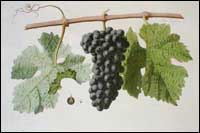 Cabernet
sauvignon Cabernet
sauvignon
Synonyms
None in Australia, but in France
also known as Petit Cabernet,
Vidure, Vidure Sauvignonne, Petit
Bouchet etc. This grape variety
is not to be confused with Cabernet
Franc.
History
Cabernet has its origins in
the Médoc, Graves, and
Gironde region of South-West
France. It was possibly known
in Roman times, but was certainly
recognised by the beginning of
the eighteenth century.
Cabernet probably arrived in
Australia in 1832 in the collection
of James Busby, but it is possible
that it may have been brought
in with the First Fleet by Governor
Arthur Phillip, and it is mentioned
by Sir William Macarthur in his
description of varieties recommended
for cultivation in Australia.
It was introduced into South
Australia by Joseph Gilbert in
the 1840s for plantings at Pewsey
Vale.
Geographical distribution
Cabernet Sauvignon is still
the dominant red grape variety
in the Bordeaux region of France.
It is now grown successfully
in many other countries including
the United States of America,
especially California, Argentina,
Chile, South Africa and Australia.
In Australia the most significant
plantings are to be found in
South Australia (especially Coonawarra,
McLaren Vale and the Barossa
Valley), Victoria (especially
the Yarra Valley), New South
Wales and Western Australia (especially
Margaret River).
Characteristics
Vine
The vine has an upright, leafy growth with deeply indented, distinctive
5-lobed glossy leaves which have a downy mauve-coloured underside.
The flowers are produced comparatively late and the berry yield
is regular but usually low.
Fruit
The bunches are small, conical and often winged. The berries are
small, loose, round, thick-skinned, blue-black in colour and
covered in bloom, producing juice with a strong varietal flavour.
Wine
With its wide distribution throughout the world wine-growing areas,
the style of the wine produced from Cabernet Sauvignon grapes
will vary according to the climate, soil and winemaking techniques
used. The wine usually has a complex bouquet and a perfumed,
rich, capsicum, multi-berry fruit palate which is often astringent,
possessing tannin and needing slow maturation. The juice from
the Cabernet Sauvignon grape may be used in the production of
rosé wine, as in the famous Anjou Rosé of France,
it may be made into a sparkling red wine and it is often blended
with other grape varieties such as Cabernet Franc, Merlot, Malbec
and Petit Verdot in the great wines of Bordeaux in South-Western
France and especially with Shiraz in Australia.
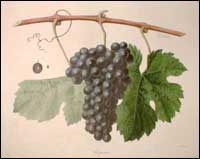 Carignan Carignan
Synonyms
In France this variety is also
known as Carignane noire, Crignare
or Plant d’Espagne. In Spain
it is also known as Tinto or
Cariñena, and in Italy
as Carignano. In Australia the
variety known as Carignan is
in fact usually the Portuguese
variety Bomvedro or Bonvedro.
History
The variety originated in Spain
probably near the town of Cariñena
in Aragon. It was known in the
Pyrenées Orientales region
of France in the twelfth century,
moving across Aude and into Mediterranean
France. Although listed in Busby’s
1832 collection and also by Macarthur,
the identification may be mistaken
and there are no records of commercial
plantings in Australia. The Carignane
of South Australia is now known
to be Bonvedro, a variety originally
from Portugal.
Geographical distribition
Carignan is one of the most
planted varieties in France,
particularly in the Pyrenées
Orientales region of South-Western
France and it is grown all round
the Mediterranean. There are
also large plantings in the U.S.A.
in California, in Spain, Chile
and Argentina. There are not
known to be significant plantings
in Australia. (see above)
Characteristics
Vine
The vine is vigorous, of upright growth and yields well. The leaves
are large, thick and 5-lobed, with an intense green smooth upper
surface and a slightly downy dull pale green under surface.
Fruit
The bunches are of medium size, long and compact, sometimes winged
and made up of unevenly ripened berries. The berries are blue-black,
oval in shape, quite thick-skinned, firm and juicy, maturing
late and very prone to fungal diseases.
Wine
The wine has hardness and astringency with little varietal character
when young and therefore is not usually presented in France as
a single varietal wine and only rarely so in California. However
it does add greatly in finesse, length, fruitiness, body and
colour to the juice of other varieties and is usually blended
with varieties such as Grenache, Morrastel, Cinsaut, Mourvèdre,
Shiraz and/or Aramon. With age Carignan loses its astringency
and hardness, developing a rounder, softer palate.
 Chardonnay Chardonnay
Synonyms
Formerly sometimes known as
Pinot Chardonnay in Australia.
In France there have been many
apparent synonyms leading to
confusion about the true variety.
The most exact seem to be Chardenet,
Chardenai, Chardenay, Chaudenay
and Chardennet, but it was occasionally
misnamed Pineau Blanc.
History
This grape variety seems to
have originated in the Burgundy
area of Eastern France, although
it was also found in early vineyards
in the Champagne area of North-Eastern
France.
The variety was first imported
into Australia in the collection
of James Busby in 1832, but it
was only after its reintroduction
into Australia in the 1950s that
there was general acceptance
of the variety, first of the
wine produced in the warmer climatic
regions and then of that coming
from cool climate regions.
Geographical distribution
Chardonnay is the dominant white
grape of the great still wines
of Burgundy especially those
of the Côte d’Or,
and is of major importance in
the production of Champagne,
the sparkling white wine of North-Eastern
France.
It is also grown successfully
in several other countries including
U.S.A., — especially California
and Oregon,- South America and
Australia.
In Australia the most significant
plantings are in South Australia,
New South Wales — especially
the Hunter Valley - and Victoria.
Characteristics
Vine
The vine produces quite vigorous growth with medium-sized, smooth,
light green leaves which are not strongly lobed and it is early
budding.
Fruit
The bunches are small to medium sized, winged, cylindrical and
usually compact. The berry varies in size and shape, but is generally
medium sized, round with a thin skin, amber-coloured when exposed
to the sun, but green in the shade.
Wine
In Australia Chardonnay has proved to be highly adaptable, growing
well in warm irrigated regions or in cooler, often higher regions
with a higher rainfall. The bouquet and palate therefore vary
according to the growing conditions and the winemaking techniques
used. Wine from the warmer irrigated regions, usually wood-treated,
has a fruity bouquet of peaches and melon and a rich soft palate
developing with age, whilst the wine from cooler regions will
generally be more acidic, fresh and more delicate in its fruit
palate. New plantings have increased significantly in these colder
areas as the fresher style has become more popular. The Chardonnay
from the latter regions is more often used in the production
of sparkling white wines, the best of which are made utilising
the traditional French Méthode Champenoise techniques.
In France, Chardonnay is represented
in the still, dry white wines
of Burgundy, which are often
golden in colour, with a rich,
fruity and long palate. The sparkling
wine from Champagne will usually
present with a light colour,
high acidity and a toasty, apple
fruit-flavoured long palate.
This style of wine is produced
by the technique known as Méthode
Champenoise and may vary in style
from dry to semi-sweet and sweet
with a small, fine, long-lasting
bead. However many Champagnes
are the result of blending Chardonnay
with Pinot Noir and Pinot Meunier
and only those known as Blanc
de Blancs are made only from
Chardonnay.
Observations
In Australia Chardonnay is often blended with other varieties.
Among the still white wines a Sémillon-Chardonnay blend
has become popular. As in France and elsewhere, Chardonnay is
widely used with Pinot Noir and other varieties in the production
of sparkling white wines. While Chardonnay has been made traditionally
in Australia with wood maturation, there is an increasing demand
for unwooded Chardonnay as consumers have reacted to an overuse
of oak.
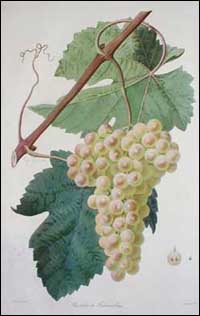 Chasselas Chasselas
Synonyms
In France also known as Chasselas
Blanc, Chasselas Doré,
Mornen, Gutedel in Alsace and
Fendant in Switzerland. There
are however many sub-varieties
in many different regions with
regional names and with individual
characteristics.
History
Chasselas may be the oldest
known cultivated variety and
its origins are not clear. It
probably originated in Asia Minor,
possibly near Constantinople.
The Phoenicians may have been
responsible for its distribution
along the Mediterranean through
Spain, up the Rhône Valley
and to Italy, however the variety
may have reached France in the
time of François 1 or
it may have originated near Chasselas
near Mâcon in Burgundy,
in the Midi or in the Cahors
region. Certainly the Swiss obtained
their Chasselas from the famous
vines at Fontainebleau in Northern
France.
Chasselas was brought into Australia
in the James Busby collection
of 1832, but it has not become
popular and although still grown
in Australia it is used as a
table grape as much as in the
production of wine.
Geographical distribution
Chasselas is distributed throughout
France because of its great popularity
as a table grape, the wine production
coming from the more temperate
regions. It is particularly successful
in Switzerland in the Valais
region and is also to be found
in Central Europe, in Germany,
Austria and Italy, in New Zealand
and Australia.
In Australia the most significant
plantings are in Victoria, with
the remainder in Western Australia
and New South Wales.
Characteristics
Vine
The vine is quite vigorous and fertile. The leaves are medium to
large, 5-lobed ,, a little rough with a smooth upper surface
of shiny green and a paler cottony under surface.
Fruit
The bunches are of medium size, cylindrical, long, winged and early-ripening.
The berries are medium in size, even, round, loose, amber in
colour when ripe, transparent and thin-skinned, and very sweet
and juicy with crisp flesh.
Wine
Chasselas usually produces a dry, delicate, undistinguished light
white wine, though it is used to produce vin de paille, a golden,
liqueur-like wine in Alsace and in Switzerland produces a popular
dry, soft white wine with a more distinctive character and which
is sometimes made into a sparkling wine.
Observations
The Cellarmaster Collection
of Rare Wine Books in the State
Library of South Australia contains
items dating from 1791 describing
and illustrating the Fêtes
des Vignerons, a very important
wine festival which takes place
in Vevey in Switzerland where
Chasselas is the principal variety
cultivated.
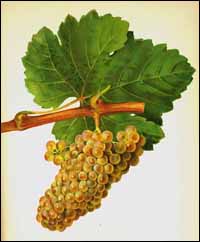 Chenin
blanc Chenin
blanc
Synonyms
None in Australia. In France
the variety is also known as
Pineau de la Loire, Blanc d’Anjou,
Plant d’Anjou, Gros Pinot
Blanc de la Loire and Gros Chenin.
In South Africa the variety is
known as Steen.
History
Chenin Blanc originated in
Anjou, south of the Loire Valley
in North-Western France and was
recognised there as early as
the ninth century. It was then
introduced to the Loire Valley
and later into the Rhône
Valley of Eastern France.
In Australia Chenin Blanc seems
to have been introduced in the
early days of settlement, possibly
in the Busby collection of 1832,
but it has often been wrongly
named. It is recorded however
that C. Waterhouse was growing
Steen at Highercombe in South
Australia in 1862 and producing
wine.
Geographical distribution
Chenin Blanc is still to be
found in France in the region
of Anjou, Touraine and the Loire
Valley. It is now also grown
in the U.S.A. especially in California,
in South Africa, Chile, Argentina,
New Zealand and Australia.
In Australia the most significant
plantings are in South Australia,
but the variety has been successfully
introduced into Western Australia.
Characteristics
Vine
The vine has vigorous growth in good growing conditions. It is
semi-upright in habit producing late-ripening fruit. The 3-5
lobed leaves have a rough, dark green upper surface and a downy
under surface.
Fruit
The bunches are medium and compact, conical in shape and winged.
The berries are of average size, oval in shape, thin-skinned
and yellow-green in colour, developing red spots and producing
a sweet juice.
Wine
The wine produced from Chenin Blanc grapes will vary in style according
to the soil, climatic and seasonal variations and the winemaker’s
treatment. In cool areas the juice is high in acid and alcohol
with a full-bodied fruity varietal palate, often leaving residual
sugar, which will usually improve with age, developing honey
and floral characteristics. When the wine is treated as a dry
white wine it will still display fruit characters with an intense
palate-as in the white wines of Anjou. When the berries are left
on the vines to develop botrytis cinerea, an intense , sweet,
viscous dessert wine is produced which will improve considerably
with age. In the Touraine area of France, the style of wine produced
will depend on the season and may range from a comparatively
dry fragrant still wine through to the viscous sweet dessert
wine. The sparkling wine of Vouvray is particularly popular and
can be made successfully even in unfavourable seasons.
In Australia Chenin Blanc is
usually presented as a crisp
dry white wine with high acid
and an intense fruit palate often
reflecting some wood treatment,
but it is also often blended
with other white grape varieties
especially Sémillon.
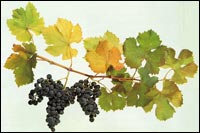 Dolcetto Dolcetto
Synonyms
None in Australia. In Italy
Dolcetto is also known as Dolsin,
Dolsin Nero and its seven DOCs
all in Piedmont are distinguished
by a district name as in Dolcetto
d’Alba, Dolcetto di Diano
d’Alba, d’Astilba,
d’Asti etc.
History
Dolcetto has been cultivated
in Piedmont since the eleventh
century, though it is said that
it may have originated in France.
It is otherwise to be found in
small plantings in Argentina
and Australia. It was first planted
in Australia in Victoria and
South Australia in the 1880s,
but it disappeared in the 1890s
except for a small area in the
Great Western district of Victoria,
where the variety was introduced
in 1867.
Geographical distribution
Dolcetto is largely to be found
in North-Western Italy in Piedmont,
where the most suitable growing
conditions for this variety exist.
Its varietal limitations and
demands restrict its distribution
more widely, but plantings are
also to be found in Argentina
and Australia.
Characteristics
Vine
The vine is not a strong grower, is prone to fungus diseases and
produces well only on sites where the environmental conditions
are most suited to its needs. The leaves are small, 3-5 lobed
and have tufted hairs on the lower surface.
Fruit
The bunches are small to medium in size, winged and loosely formed.
The berries, which are the first to ripen in Piedmont, are small,
round and acquire a heavy bloom.
Wine
Dolcetto juice possesses a high sugar and acid content, with medium
alcohol and low tannin levels. The wine has a clear, brightly
coloured red appearance, and a fruity, floral, smooth palate
often with traces of almonds. As it matures quickly, it is therefore
drunk young.
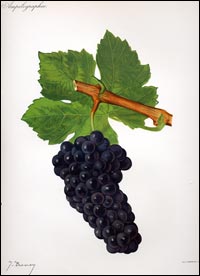 Durif Durif
Synonyms
None in Australia. The variety
is also known as Plant Durif,
Plant Fourchu, Pinot de Romans
and Pinot de l’Hermitage
(although not related to Pinot)
in France. In California where
it is grown with and not always
distinguished from Peloursin,
it is known as Petite Sirah.
History
Durif was developed by a Dr
Durif in South-East France about
1880 and possibly grown from
a seed of the variety Peloursin
with which it is often grown
and from which it is not always
distinguished nor separated.
Geographical distribution
Durif was found originally in
Isère, Ardèche
and Savoie, but the plantings
have decreased greatly in recent
times. However it is now widely
planted in California where it
is usually associated with Peloursin.
In Australia, the largest plantings
are to be found in North-Eastern
Victoria.
Characteristics
Vine
The vine is vigorous and spreading in growth. The leaves are medium
to large in size, usually 5-lobed, with a mat bright green upper
surface and a paler green almost mat lower surface.
Fruit
The bunches are medium to large in size, cylindrical, fairly compact
and slightly winged. The berries are black, small to medium in
size, almost oval although the shape may be affected by the tightness
of the bunch, firm, quite thick-skinned and produce sweet juice.
Wine
The wine is deeply coloured, with a high level of tannin and a
spicy, plum fruit palate. In California it may be used as a blending
wine. In Australia it is also used to produce sparkling red wines.
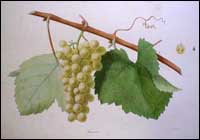 Furmint Furmint
Synonyms
None in Australia, but the variety
is known as Tokay in France,
as Tokayu in Hungary and as Tokayer
or Edler Weisser in Austria and
Germany. The fortified wine known
as Tokay originating in North-Eastern
Victoria in Australia is however
made from Muscadelle grapes.
In Yugoslavia Furmint is also
known as Sipon, Mislovai and
Bijeli.
History
Furmint probably has its origins
in Hungary, though it may have
been brought into Hungary in
the early thirteenth century.
It then made its way into the
Hérault, Gard and Languedoc
regions of France in the early
nineteenth century. Furmint was
introduced into Australia in
Busby’s 1832 collection,
but was not widely grown though
plantings were recorded at Great
Western in Victoria in 1868.
Geographical distribution
Furmint is grown principally
in Austria, Hungary, Czechoslavakia
and Yugoslavia and other countries
in Central Europe and Eastern
U.S.S.R. It is not widely grown
in Australia.
Characteristics
Vine
The vine is upright in growth, but neither very vigorous nor very
fertile. The leaves are almost round, with a bright green upper
surface but a matt very light-coloured downy under surface.
Fruit
The bunches are of medium size, cylindrical in shape and sometimes
winged. The berries are round, uneven in size with semi-transparent
skins, soft and golden in colour on maturity and usually picked
late, though ripening early and susceptible to rot.
Wine
The juice is high in acid and alcohol content and may be bitter-sweet
but it produces a strong varietal wine in Hungary and Eastern
Europe. It is better known however when used in the production
of fine sweet dessert wines like those from Languedoc in South-Western
France as in the Tokay Princesse or in the Tokay wines from Hungary,
where the Tokay is blended with Harslevelu and the bouquet and
palate develop with age.
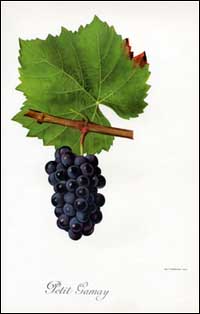 Gamay Gamay
Synonyms
None in Australia. In France
it is also known as Gamai Nicolas,
Gamay Noir à Jus Blanc,
Petit Gamai, Gamai Rond, Bourguignon
Noir, Petit Bourguignon.
History
The vines introduced by the
Emperor Probis in 280AD to the
Lyon region of Eastern France
and which probably originated
in Dalmatia seem to be the origin
of the modern Gamay Noir à Jus
Blanc, though it is also possible
that it originated further to
the north of Lyon in Burgundy.
Many of the subvarieties were
high-yielding but produced poor
quality wine and therefore the
cultivation of Gamay was forbidden
in Burgundy in 1395. Nevertheless
the variety survived and spread
gradually to Franche Comte, Touraine,
the Loire and the Ardèche.
The history of the introduction
of Gamay into Australia is not
clear. Although a Gamay Noir from
the Haute Saône is mentioned
as Nr.186 in James Busby’s
1832 collection, it seems that
the true Gamay clones now in
Australia are of comparatively
recent introduction.
Geographical distribution
Once one of the most widely
cultivated grape varieties in
France the plantings are now
to be found mostly in Beaujolais,
Burgundy and the Loire Valley.
The variety is also to be found
in Italy, especially in Tuscany
since 1825, and in adjoining
areas of Yugoslavia, Switzerland,
Austria and Roumania, in Chile
and Argentina.
In Australia Gamay is grown
on the Mornington Peninsula and
near Beechworth in Victoria.
Characteristics
Vine
The vine is moderately vigorous and a prolific bearer. The leaves
are usually entire but may be 3-lobed, small to medium in size,
pale green, smooth and shiny with a yellow-green hairless lower
surface.
Fruit
The bunches are of medium size, compact, conical in shape and sometimes
winged.The berries are black, covered with bloom, medium sized,
oval with firm skin but soft, white, sweet flesh and ripen early.
Wine
Gamay produces a high acid, low tannin, medium weight, light coloured
red wine with a distinctive fresh fruity nose ready for immediate
drinking. The wine usually appears under the regional name of
Beaujolais (Eastern France), where Gamay is the dominant variety
grown. Much of the juice is processed quickly from whole rather
than crushed grapes to produce an often chaptalized and short-lived
wine, but high quality wine can be produced when traditional
techniques and fruit from the vineyards most suited to its cultivation,
as in Haut Beaujolais, are used. The Loire Valley (Western France)
also produces Gamay and the variety is often used in Rosé wines
such as those from Anjou, but it is processed similarly in other
regions.
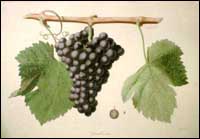 Grenache Grenache
Synonyms
None in Australia. In Spain
known as Granacha, Garnacha and
Garnache, as Alicante or Granaccia
in Sicily and France and as Cannonau
in Sardinia.
History
Grenache originated in Spain,
probably in Aragon, and plantings
spread through Roussillon, Southern
Mediterranean France and eastwards
into the Mediterranean regions
of Southern Europe.
The variety was introduced into
Australia by James Busby in his
1832 collection, having been
personally collected from Perpignan
in Roussillon. In South Australia
it was introduced by Dr Christopher
Rawson Penfold who arrived in
the state in 1844 bringing with
him Grenache cuttings from the
South of France.
Geographical distribution
Grenache is grown throughout
Mediterranean Southern Europe
from Spain to Sicily, with plantings
increasing in Southern France.
The variety is also grown in
South Africa, the U.S.A. — especially
in the Central Valley of California-
and in Australia — especially
South Australia. The plantings
in South Australia are particularly
important in McLaren Vale, the
Barossa Valley and Clare.
Characteristics
Vine
The vine is vigorous and upright in its growth with good wind tolerance
and is suited best to warm, dry and stony growing conditions.
The 3-lobed somewhat closed leaves are shiny, yellowy-green in
colour with clear veins and with a paler undersurface devoid
of hair.
Fruit
The bunches are winged, irregular, of medium size and cone-shaped.
The berries are rounded, blue-black and covered in bloom, thick-skinned
and juicy.
Wine
The juice is sweet, varying in colour and richness, according to
the climatic conditions and viticultural practices, as quality
is dependent on controlled productivity. It is generally spicy,
berry-flavoured and soft on the palate with a relatively high
alcohol content, but may be lacking in acid, tannin and colour.
Grenache is usually used to
make one of three styles of wine.
It is used alone in the famous
Rosé wines from the Tavel
district of the Côtes du
Rhône in South-Eastern
France and in some regional dry
red wines. However a second style
emerges when other red grape
juice is added to the Grenache
as with Mourvèdre (Mataro)
and Cinsault in the wines from
the Côtes du Rhône
in South-Eastern France or indeed
with a selection from thirteen
recognised varieties as in the
wines from the nearby Châteauneuf
-du -Pape. Grenache is also used
alone in the Banyuls region of
Roussillon in Southern France
to produce fortified sweet wines
known as vins doux naturels.
In Australia, the consumer has
developed an interest in dry
red varietal wines made from
Grenache, often produced from
old vines which when grown in
optimum conditions produce a
rich, deeply coloured, aromatic,
berry-fruit flavoured and full-bodied
wine with a high alcoholic content.
It is also blended successfully
with the other varieties customarily
used in the wines from the Côtes
du Rhône region of South-Eastern
France such as Mourvèdre
(Mataro) and Shiraz. Grenache
is also used to produce a fortified
wine of a Port style.
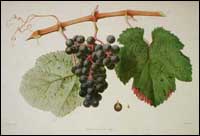 Malbec
or cot Malbec
or cot
Synonyms
None in Australia. In France,
although usually known as Côt,
it may also be known as Noir
de Pressac, Gourdoux, Estrangey,
Côte-Rouge, Pied de Perdrix,
Malbec (Gironde) or Auxerrois
(Cahors, also in South-Western
France).
History
Malbec seems to have its origins
in South-Western France near
Cahors and was known to be in
the Gironde region in the 1780s
and then in Touraine. In Australia,
although recorded in James Busby’s
1832 collection, it was possibly
misnamed and Macarthur writes
of it in 1844 as having been
sent out by Barton and Guestier
from Bordeaux and likely to be
well-suited to Australian conditions.
Geographical distribution
Malbec is still to be found
in the Cahors district of the
Gironde region of South-Western
France and in Touraine (Loire),
although in diminishing quantities.
It is also grown widely in Argentina
and Chile, while there are also
small plantings in the U.S.A.
and Australia, mostly in South
Australia.
Characteristics
Vine
The vine is upright, vigorous, early-fruiting, a heavy bearer and
disease-free in a good season, with broad 3-5-lobed dark green
leaves often yellowish on the edges, with a smooth upper surface
and a whiter, hairy under surface.
Fruit
The bunches are large, winged, loose, long in shape and plentiful.
The berries are blue-black in colour, round, medium-sized, thin-skinned,
producing a very sweet, clear and generally full-flavoured juice.
Wine
The depth of colour and palate and the levels of acid and alcohol
in wine produced from Malbec are greatly dependent on the variations
in growing and climatic conditions in the different regions of
production. Generally Malbec provides a light style wine of good
colour, sweet, not very aromatic but with berries and spice on
the palate, maturing quickly and at its best when drunk young.
The juice is however usually blended with that of other grape
varieties. To the wine of Cahors, the high level of alcohol,
acid, tannin and colour give body, richness and colour to the
wine. It is also used in the wines of St Emilion and Graves in
the Gironde area, where it is softer with less acid, and adds
delicacy. In Chile too it is used with the traditional Bordeaux
varieties of Merlot, Cabernet Franc and Petit Verdot. In Australia
it produces a wine with good tannin and colour but is mostly
used for blending especially with Cabernet.
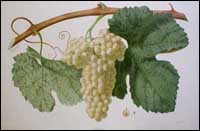 Marsanne Marsanne
Synonyms
None in Australia. In France
Marsanne is also known as Marsanne
Blanche, Grosse Roussette or
Avilleran and in Switzerland
as Ermitage or Ermitage Blanc.
History
Marsanne is recorded from earliest
times as present in the Marsanne
region of Montélimar and
on the slopes of Hermitage in
South-Eastern France.
Marsanne was introduced into
Australia in the Busby collection
of 1832 and is known to have
been grown in Victoria since
the 1860s. The vines at Tahbilk
may be the oldest Marsanne vines
in the world still in production.
Geographical distribution
Marsanne is grown in the Northern
Rhône area of South-Eastern
France. It is also grown in the
Valais in Switzerland and there
are small plantings in Australia
with areas in New South Wales
and in Victoria, with the wines
from Nagambie in Central Victoria
being of particular interest.
Characteristics
Vine
The vine is vigorous, high-yielding and well-suited to warm, dry
and stony growing conditions. The leaves are large, round, rough,
usually 3-5 lobed with a matt dark green upper surface and a
lighter coloured tufted lower surface.
Fruit
The bunches are conical, winged, medium-sized and loose. The berries
are small, round, fairly thin-skinned and become a deep golden
colour on ripening. The flesh is soft, juicy and sweet.
Wine
The juice is distinguished by its high alcohol level and deep colour
and may be aged in oak. In France a light, dry, short-living
varietal wine is produced and while its counterpart in Australia
possesses more body and character, it also does not usually age
well, though different wine-making techniques are now leading
to longer-living wines. However Marsanne juice in the Rhône
region of France was and may be added to Shiraz to add finesse
and is the major variety used in the production of the famous
white Crozes-Hermitage and the sparkling and still white wines
of St. Péray. The addition of juice from the Roussanne
grape variety to Marsanne results in a more aromatic, delicate
and interesting wine, and these two varieties are of great importance
in the production of the white wines of the Rhône.
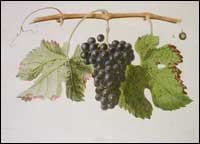 Merlot Merlot
Synonyms
None in Australia. In France
sometimes known as Vitraille.
History
Merlot seems to have originated
in the Bordeaux region of South
West France, although it was
only recognised in the eighteenth
century. The variety has become
increasingly important with plantings
spreading across Southern France.
In Australia Merlot was introduced
in the 1960s by the C.S.I.R.O.
as it sought to trial a wider
range of grape varieties.
Geographical distribution
Merlot is a major grape variety
of the Bordeaux area of South
West France and has now been
introduced into grape growing
regions across Southern France.
It is also to be found in U.S.A. — especially
California - Chile, Italy and
Australia and plantings are increasing
generally.
In Australia, South Australia
has led the way in producing
outstanding wines from this variety.
Characteristics
Vine
The vine is vigorous and quick growing, with thick, dark green
leaves usually 5-lobed, with a rough upper surface and a hairy
under surface.
Fruit
The bunches are quite large, cylindrical, sometimes winged and
loosely made up of early and unevenly-ripening berries, which
are blue-black in colour and crisp, sweet and juicy.
Wine
The bouquet is aromatic and the berry-plum qualities are reflected
in the palate. The wine is usually medium red in colour, medium
bodied, soft and round and generally made for early drinking
rather than slow maturation.
Observations
Although in Australia Merlot
is now achieving considerable
recognition as a varietal wine,
it is more widely known for its
contribution to the palate when
blended with other red grapes.
The combination of Merlot with
Cabernet Sauvignon, where the
softness of the Merlot counterbalances
the tannin and sometimes hardness
of the Cabernet while the Cabernet
adds length of palate, is highly
effective and probably the most
popular. This combination may
also be varied with the use of
Cabernet Franc or Malbec as found
in the great red wines of Bordeaux,
all used in varying proportions
according to the individual regional
and local characteristics and
vintage conditions.
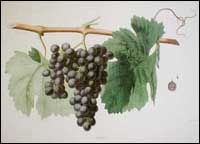 Mourvedre Mourvedre
Synonyms
In Australia also known as Mataro,
as Balzac in the Corowa region
of New South Wales and as Esparte
in the Great Western district
of Victoria. In Spain the variety
is known as Murviedro, Mataro,
Monastrell, Morastell, l’Espar
or Tinto. In France it is also
known as Mataro, Carignane in
Hérault, Balzac in the
Cognac region and as l’Espar
in Languedoc.
History
Mourvèdre has its origins
in Spain where it was already
recognised in the sixteenth century,
identified as Murviedro in the
old kingdom of Valence and as
Mataro in Catalonia. The variety
then spread across Roussillon
and eastwards across Southern
France. Widely grown, the plantings
were greatly reduced after the
outbreak of phylloxera in France
in the 1860s and are only recently
becoming more widespread again.
The variety was brought into
Australia in the Busby collection
of 1832 from Perpignan (Roussillon)
and although not highly rated
by Macarthur, it managed to survive.
Geographical distribution
Mourvèdre is widely planted
in Spain and is found throughout
Mediterranean France to the Bouches
du Rhône. It is also grown
in the U.S.A.- especially in
California - and in Australia.
In Australia the most significant
plantings are in South Australia
and in New South Wales.
Characteristics
Vine
The vine is upright and of vigorous growth with medium-sized 3-5
lobed leaves, dark green in colour with a downy under surface.
Fruit
The bunches are medium-sized, long, conical and winged. The berries
are round, medium-sized, blue-black in colour covered with bloom,
with thick skins and a somewhat bitter juice.
Wine
The wine possesses good colour, is rich and though it may be comparatively
neutral on the palate, it is more usually quite astringent when
young, high in acid and alcohol, but perfumed and it will soften
with age. Its astringency has led to its use as an important
blending wine rather than as a varietal wine, and it is used
as one of the thirteen varieties accepted in the production of
the famous Châteauneuf-du -Pape from the Rhône Valley
of Southern France.
In Australia Mourvèdre
is used either as a varietal
wine or is blended with other
varieties commonly used in the
wines from the Rhône Valley
of France such as Grenache, Shiraz
etc.
Mourvèdre is occasionally
used to produce a vin de liqueur
as in South-Western France or
in a port style wine in Australia.
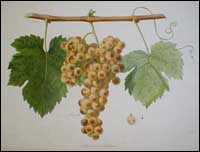 Muscat
de frontignan Muscat
de frontignan
Synonyms
In Australia also known as Muscat à petits
grains, Brown Muscat or Frontignac.
This variety has many different
names all over the world. In
France it is also known as Muscat
Blanc (de Frontignan), Muscat à petits
grains or Muscatel, in Portugal
as Muscatel Branco, do Douro
etc., in Spain as Moscatel Menudo
Branco, Bruno etc., in Italy
as Moscato Bianco, d’Asti
etc. and can be recognised in
Muskat, Muskatel, Muskateller
etc. in Germany and Austria.
History
As the oldest grape variety
known, probably originating in
Ancient Greece and then carried
through Italy into Roman France,
it is recorded as being exported
from the port of Frontignan in
South-West France during the
reign of Charlemagne. Muscat
de Frontignan was introduced
into Australia in the Busby Collection
of 1832 and endorsed by Macarthur
in 1844 as a suitable variety
for Australian conditions.
Geographical distribution
Muscat de Frontignan is widely
distributed but not always grown
in large quantities, and while
there is a stable white variety
there are other sub-species which
produce grapes of the three colours
red, rosé and white on
the same vine irregularly. It
appears that the stable white
variety is more common in Europe
and the irregularly coloured
sub-species more common in Australia
and South Africa. Muscat de Frontignan
is present in Mediterranean France,
in Hérault, the Pyrenées
Orientales and Bas Languedoc,
though plantings decreased greatly
after the outbreak of phylloxera.
The variety is also present in
Italy, Spain, Hungary, Samos
(Greece), the U.S.A. especially
California, Argentina, South
Africa and Australia.
In Australia approximately half
is grown in South Australia and
other plantings are to be found
in New South Wales and the Rutherglen
area of North-East Victoria where
it is known as Brown Muscat.
Characteristics
Vine
The vine is vigorous, semi-erect, spreading and low-yielding. The
leaves are of medium size, 3-5 lobed, thin, smooth, with a dark
green upper surface and a paler, hairless under surface.
Fruit
The bunches are of medium size, elongated, cylindrical, compact
and sometimes winged. The berries are medium-sized, usually round,
transparent but becoming opaque on maturity and golden yellow
in colour with reddish spots. They ripen early and dry out readily
but are very often left to develop a high sugar concentration.
The flesh is firm and very sweet with the juice distinguished
by a distinct flavour of musk.
Wine
The wine produced from Muscat de Frontignan grapes is often blended
with other varieties and will vary in style from a sparkling
white wine with a fruity musky palate as in the Clairette de
Die of South-Eastern France through a dry still white wine as
is the Frontignac of the Barossa Valley of South Australia, a
vin doux naturel such as that of Rivesaltes in South -- Western
France, a vin de liqueur and then to the full-flavoured, rich,
fortified dessert wines which are long lasting, maturing and
developing very slowly to become wines of very great quality
as in the Muscat de Beaumes de Venise of South-Eastern France
and the Brown Muscat from Rutherglen in Victoria.
Nebbiolo
Synonyms
None in Australia. In Italy
Nebbiolo is also known as Spanna,
Spana, Picotenet, Pugnet (in
Aosta) and Chiavennasca (in Lombardy).
There are also several sub-varieties.
History
The first historical reference
to Nebbiolo was made in the thirteenth
century placing it in the Alba
district near Turin, though it
is thought that the variety was
known to the Romans. Now it is
recognised for its contribution
to the quality wines of Barolo
a and Barbaresco.
Nebbiolo was introduced into
Australia from the University
of California, Davis, for the
vine breeding programme of CSIRO
at Merbein, but the small commercial
plantings presently in Australia
came from the later UCD cuttings
sent to Merbein in 1974 or from
cuttings sent from the University
of Turin in 1989.
Geographical distribution
The largest plantings of Nebbiolo
are to be found in Piedmont in
North-Eastern Italy. The naming
of the grape seems to have been
influenced by the fog usually
present during the vintage season.
It is here that Nebbiolo produces
its best in terms of quality
as the environment provides perfect
growing conditions for the special
requirements of this demanding
variety. It is also to be found
in small quantities in Argentina,
California, Switzerland, Uruguay
and Australia, where small plantings
are being trialled in especially
selected areas of the King Valley
region of Victoria, the Margaret
River region of Western Australia
and the McLaren Vale region of
South Australia.
Characteristics
Vine
There are several sub-varieties but the vine is generally vigorous
and bears well, although the climatic and soil conditions are
of particular importance for the quality of wine produced, and
the juice requires careful handling. The leaves are 5-lobed and
dark green with an irregular upper surface. The lower surface
is very hairy.
Fruit
The bunches are of medium size, compact, conical in shape and winged.
The berries are of medium size, round in shape, covered in bloom,
tough skinned and ripen late in the season.
Wine
The juice from the Nebbiolo grape is high in acid, alcohol and
tannin content. It benefits from long barrel maturation to develop
as a rich, dry red wine with a fruity berry and floral nose and
a complex full palate which will continue to improve with age.
Nebbiolo is used in the production of sparkling or still dry
or sweet red table wines.
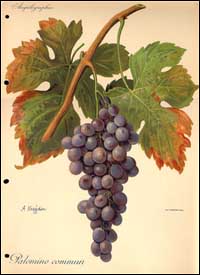 Palomino Palomino
Synonyms
In Australia the variety is
also known as Paulo. This white
grape is the Listan (d’Andalousie)
from Spain and should not be
confused with the red grape recorded
much earlier in historical records
as Palomino Commun. In France
and Spain Palomino is commonly
known as Listan, in Spain also
as Alban, Temprana or Tempranilla,
in Portugal as Perrum, in South
Africa as White French and in
California wrongly named as Golden
Chasselas.
History
Palomino originated in Andalouscia
where it is the major component
in the production of sherry.
It is listed in Busby’s
1832 collection as one of the
grape varieties he collected
from Malaga under the name of
Temprana.
Geographical distribution
Spain is the major producer
of Palomino grapes particularly
in the region of Jerez, but the
variety is also to be found in
Southern Portugal, the Midi area
of Southern France, in South
Africa, California and Australia,
where it is used mainly in the
production of sherry. Edward
Peake was the first to introduce
the variety into South Australia,
when he imported Palomino cuttings
directly from Spain for his vineyard
at Clarendon in 1849.
Characteristics
Vine
The vine has spreading growth, is semi-erect, fairly vigorous and
is generally high-yielding.
The leaves are medium to large
in size, deeply indented and
5-lobed. They have a rough dark
green upper surface and a very
hairy lower surface.
Fruit
The bunches are large, conical, winged and loose. The berries are
of medium size, round, firm, tough-skinned, early ripening and
become golden and darker in colour as they ripen with a light
bloom.
Wine
The juice is low in acid content with a comparatively neutral aroma.
Palomino is used most often in the production of fortified wines,
particularly sherry, in Spain, South Africa and Australia, though
it is also used to produce a dry, fresh, pleasant white table
wine in Southern Spain and South Australia.
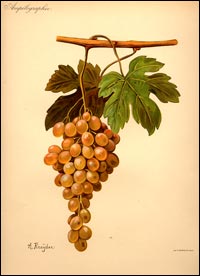 Pedro
ximenez Pedro
ximenez
Synonyms
None in Australia. Whilst the
name Pedro Ximénez is
widespread in Spain, it is also
known as Ximénès
and Pedro Ximen, and as Jiménez
and Pedro Jimènez in Andalusia
and as Pedro Giménez in
Argentina..
History
Pedro Ximénez is thought
to be of Spanish origin and is
still widely grown in Southern
Spain. James Busby brought specimens
back from Xeres de la Frontera
in his 1832 collection, but MacarthurArthur
makes no mention of it in his
notes on his experiments with
those vines surviving from that
collection which showed good
adaption to Australian conditions.
However Dr A.C. Kelly mentions
the variety in his book The
Vine in Australia (1861)
as having been imported directly
from Jerez into South Australia
to be planted at Clarendon and
also that some vines had come
from the Sydney Botanic Gardens
to the Adelaide Botanic Gardens
in about1839.
Geographical distribution
In Spain Pedro Ximénez
is to be found nowadays mostly
in Andalusia, Extramadura and
Valencia. It has been considered
to be the most important white
variety of Argentina, though
there is now some doubt about
the authenticity of that variety.
There are also small plantings
in California, Chile and Australia.
Characteristics
Vine
The vine is of upright and vigorous growth. The leaves are small
to medium in size, bright green, with a smooth, flat upper surface,
and a lower surface with hairs on the clearly defined veins.
They are 5-lobed and slightly irregular in shape.
Fruit
The bunches are below average to average in size, cylindrical,
winged and compact. Although the berries may vary in size they
ripen at the same time. The berries are almost globular, thin-skinned,
transparent and soft, producing a very sweet juice.
Wine
Pedro Ximénez produces wine of good quality with a fine
and pleasant though neutral palate. The variety is associated with
the production of sherry and other dry and fortified wines in Spain,
but it is used to make a dry white table wine in Southern Spain
and is often blended with other white varieties in Spain and Australia.
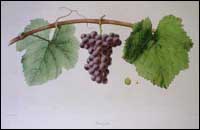 Pinot
gris Pinot
gris
Synonyms
In Australia also known as Pinot
Grigio. In France also known
as Pinot Beurot, Gris Cordelier,
Auvernat Gris, Malvoisie, Tokay
d’Alsace and Fromentot.
In Germany known as Ruländer
and in Italy as Pinot Grigio.
History
Pinot Gris is a variant of Pinot
Noir and usually grows with it.
It is therefore considered to
have originated in the Burgundy
region of Eastern France and
indeed Pinot varieties were mentioned
in thirteenth-century French
manuscripts.
Pinot Gris was introduced into
Australia in the James Busby
collection of 1832 but has only
recently been developed as a
varietal wine.
Geographical distribution
Pinot Gris is generally found
wherever Pinot Noir is grown,
especially in France where it
is to be found in Burgundy, but
nowadays it is better known in
Alsace. There are plantings in
Germany, Italy and in Central
and South-East Europe, in U.S.A.
where small plantings have been
established in several states,
and in Australia.
In Australia, although a variety
bearing that name was introduced
in 1832, it is only in the 1990s
that the true variety has achieved
recognition by growers and consumers,
with the most important but small
plantings located in Victoria,
and Tasmania and South Australia..
Characteristics
Vine
As a mutation of Pinot Noir, the vine is delicate in its growth,
low-yielding, late-developing with early-ripening fruit. The
leaves are large, 5-lobed when noticeable, thick with a smooth
green upper surface and a yellowy-green, downy under surface.
Fruit
The bunches are small, winged, cylindrical but often loosely shaped.
The berry is small, less pigmented than that of the Pinot Noir,
varying in colour from pink to grey, transparent and firm, producing
a fine, sweet juice.
Wine
The wine, yellow to golden in colour and usually with a low acid
level, has a long, dry often perfumed fruity palate, though it
may vary from a light early picked wine as in Italy to a full-bodied
style-even late harvest in style as in Alsace-depending on the
winemaking techniques used.
In Australia the varietal label
Pinot Gris will usually indicate
a wine made in the full-bodied
style of Alsace in France and
Germany, whilst the label Pinot
Grigio will usually indicate
that the wine is made in the
dry, lighter, Italian-influenced
style.
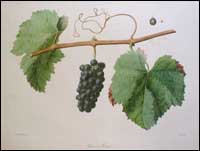 Pinot
noir Pinot
noir
Synonyms
None in Australia, but also
known as Pineau, Noirienr and
Morillon in France and de Burgunder
or Klevner in Germany.
History
This grape variety probably
originated in the Burgundy region
of Eastern France and was later
identified in the Champagne region
of North Eastern France.
In Australia Gregory Blaxland
was thought to be making wine
from Pinot Noir in the 1820s
after arriving in Sydney with
vine cuttings from the Cape in
1805. It is known that Pinot
Noir was represented in the Busby
Collection of 1832, but although
plantings were maintained in
the Hunter Valley region of New
South Wales, it was only in the
1970s that interest grew in the
variety and plantings were expanded.
Geographical distribution
Pinot Noir is the dominant red
grape variety of the Burgundy
region of France, especially
the region of Côte d’Or.
It is also of great importance
in the Champagne region of North
Eastern France where it is blended
with Chardonnay to produce the
famous sparkling wine of the
region.
There are also plantings in
many other countries including
the U.S.A. — especially
California and Oregon - and in
Australia.
In Australia the most important
plantings are currently in South
Australia — especially Coonawarra
and the Adelaide Hills -, in
New South Wales in the Hunter
Valley, and in Victoria in the
Yarra Valley, on the Mornington
Peninsula and in the Geelong
region.
Characteristics
Vine
There are many different clones grown, developed to suit the different
climatic and soil conditions as the variety generally benefits
from a cool climate rather than a hot, dry one. The vine itself
is slow to mature, low yielding with early-ripening fruit. The
leaves are pale green with a matt surface, medium-sized, often
almost round, not deeply indented and have a hairy undersurface.
Fruit
The bunches are small, generally compact and made up of small,
tightly packed, slightly oval, sweet, juicy grapes with a dark
violet, bloom-covered skin.
Wine
In Australia the colour, bouquet and palate vary considerably according
to the clone and growing conditions. Whilst wine produced from
warm region Pinot Noir may often lack depth of colour , varietal
aroma and palate, the wine from cooler areas is of a darker colour,
is a medium-bodied more complex wine with a cherry/strawberry
aroma and palate which with age may develop characteristics more
reminiscent of Burgundy with the fruit becoming more like plums
and with a longer palate.
When used for the production
of sparkling white wine Pinot
Noir may be blended with several
white wine grape varieties or
as in the superior quality wines
resembling Champagne, with Chardonnay
and Pinot Meunier. The best of
these wines are made according
to the traditional French Méthode
Champenoise. The aroma and palate
will range from the dry to the
sweet and the best will possess
a good bead, a fresh, fruity
aroma and a delicate but complex
and lasting palate.
Observations
In France the Pinot Noir grape
is recognised as the grape used
in the great and world-renowned
red wines of Burgundy, especially
from the Côte d’Or
region, and for its use, especially
when blended with the Chardonnay
and Pinot Meunier grapes in the
Champagne region, to produce
the equally world-renowned sparkling
white wine known as Champagne.
The style known as Pink or Rosé Champagne
has been developed from residual
Pinot Noir skin colouration.
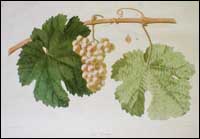 Riesling Riesling
Synonyms
In Australia this variety was
also known as Rhine Riesling
to avoid confusion with Clare
Riesling (Crouchen) and Hunter
River Riesling (Sémillon).
Elsewhere it is also known as
Riesling Blanc and Weisser Riesling.
History
Riesling has its origins in
the Rheingau region of Germany.
In Australia James Busby listed
Rischling in his 1832 collection
and it is known that William
Macarthur imported some Riesling
vines from the Bas-Rhin in 1838.
In 1847 Johann Gramp imported
some Riesling grapes into the
Barossa Valley of South Australia,
producing his first vintage in
1850.
Geographical distribution
Riesling is the dominant grape
variety of Germany and plantings
stretch through the vine-growing
areas of Central Europe. In terms
of region, the plantings in the
Alsace region of North-Eastern
France, in California in the
U.S.A. and in Australia are also
important.
In Australia the most significant
plantings are in South Australia,
with wine from the Clare, Eden
Valley and Barossa Valley regions
being of particularly high quality
and interest. More recent plantings
of Riesling in the Margaret River
region of Western Australia and
in Tasmania are also now producing
excellent wines.
Characteristics
Vine
The vine, of semi-upright and vigorous growth in cool climates,
has small, thick, dark green leaves, usually 5-lobed, with a
paler undersurface.
Fruit
The bunches are usually small, tight, winged and cylindrical in
shape. The berries are usually small, round, thick-skinned and
pale yellow becoming darker and speckled when ripe.
Wine
The wine will vary in style according to the regional and climatic
variations. It may be dry, with high acid and slightly sweet
through to very sweet if the fruit has been affected by botrytis
and/or frost. The nose is aromatic and delicate when produced
from grapes grown in a cool climate with lime and citrus fruit
and sometimes slightly spicy. The colour will vary from a very
pale yellow with a slightly green and often brilliant tinge when
young and from a cool region developing with age into a golden,
honey-coloured sometimes viscous wine. The palate will vary from
the crisp, acid flavour of the young wine to the rich, honey,
spicy, toasty palate of the developed wine. Thus the fresh, acid,
dry wines from Alsace contrast strongly with the much sweeter,
lighter, often highly aromatic wines of Germany culminating in
the botrytis and/or frost affected Trockenbeerenauslese and Eiswein
styles of the Rheingau. The wine produced from botrytis and/or
frost- affected grapes is usually very sweet, golden with a lime
and tropical fruit palate with some viscosity.
Observations
In Australia, Riesling is now
regaining its popularity after
a decline in demand. Although
sweet dessert style wines are
made, the crisp, acidic usually
dry but fruity Rieslings from
South Australia are outstanding.
Riesling is also now being blended
with other white varieties especially
Gewürztraminer.
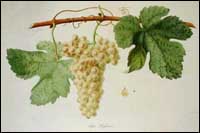 Roussanne Roussanne
Synonyms
None in Australia, but also
known in Franceas (Petite) Rousette
in Eastern France, in Ardèche
and Ain, as Bergeron in Savoie,
Plant de Seyssel in Ain and as
Fromenteau in Isère.
History
Roussanne seems to have originated
in the area where it is mainly
grown in the Côtes du Rhône
and the valley of the Isère
in Eastern France.
In Australia Roussanne is named
by James Busby as part of his
1832 collection, but it is not
mentioned by Macarthur in his
comments on the suitability of
various grape varieties for Australian
conditions. However Roussanne
was reintroduced into Australia
by the CSIRO in 1982.
Geographical distribution
Plantings of Roussanne are to
be found in regions with a Mediterranean
climate such as those of the
Upper Rhône Valley of Eastern
France and the Var, and in the
Tuscany region of Italy near
Lucca.
In Australia the significant
plantings are in the Yarra Valley
of Victoria.
Characteristics
Vine
The vine is vigorous and semi-erect but may be fragile. The leaves
are medium to large in size, quite thick, 3-5 lobed and rough
with a dark green upper surface and a downy lower surface.
Fruit
The bunches are of medium size, elongated, semi-cylindrical and
clearly winged. The berries are small, round, sometimes irregular,
very golden and develop rust coloured spots on maturity. The
skin is firm with crisp flesh and very sweet juice.
Wine
Roussanne is very rarely used to produce a varietal wine but more
usually blended with Marsanne to produce the famous white wine
of Hermitage from the Rhône Valley of Eastern France, adding
elegance, delicacy and aroma to the Marsanne, the quality of
the Roussanne improving with age. It is also used to produce
the vin de paille of the same region, with the juice becoming
thick and viscous, and in the sparkling wine of Saint Péray
and it may be used in Châteauneuf -—du -Pape. It is
also used in the production of Montecarlo Bianco in Tuscany in
Italy.
In Australia Roussanne is usually
used with Marsanne in the Yarra
Valley of Victoria to produce
a Rhône style wine.
Sangiovese
Synonyms
There are many subvarieties
of Sangiovese, but these notes
deal with Sangiovese Grosso,
also known as San Gioveto in
Tuscany and in other parts of
Italy as Prugnolo, Brunello,
Calabrese, Uvetta, Montepulciano
etc.
History
The variety seems to have originated
in Tuscany and was already well
known in the sixteenth century.
Limited originally to Tuscany,
by the nineteenth century Sangiovese
Grosso had spread to Emilia-
Romagna and then widely throughout
Italy. It was introduced into
Australia by the CSIRO in the
late 1960s and developed commercially
at Mudgee in New South Wales.
Some Italian clones were introduced
in the 1980s followed by further
importations in 1990.
Geographical distribution
Sangiovese is widely grown throughout
Italy. There are also small plantings
in USA, especially in California,
in Argentina and in Australia.
In Australia the most significant
plantings are those in the Mudgee
area of New South Wales, in McLaren
Vale in South Australia and in
the King Valley in Victoria.
Characteristics
Vine
The vine is moderately vigorous, has a good resistance to disease
and generally yields moderately to well. The leaves are dark
green, regular, slightly elongated, usually 3-lobed with a shiny,
smooth and flat upper surface and a light green, slightly hairy
lower surface.
Fruit
The bunches are of medium size, conical, winged and loose. The
berries are small to medium in size, oval, blue-black with thick,
tough skins covered in bloom and juicy.
Wine
The berries produce a light-coloured, slightly bitter juice of
medium sweetness with a distinctive nose. The wine has a high
acid level, with tannin, moderate alcohol and a dry, earthy,
full-flavoured palate. The quality of the wine depends on the
naturequality of the clone and there are therefore wide variations
in standardquality, depth of colour, flavour and ageing potential.lasting
qualities. This is the grape variety used in the famous wine
of Brunello di Montalcino in Southern Tuscany, but the juice
is usually blended with that of other varieties and is a major
component of the top Chianti wines, usually making up 75% -90%
of a blend with Canaiolo, Trebbiano etc. It is increasingly being
blended with Cabernet in Italy to produce red wine of excellent
quality.
In Australia, where production
is small, Sangiovese is usually
used to produce varietal wines,
but may be found blended with
other varieties.
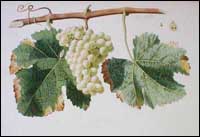 Sauvignon
blanc Sauvignon
blanc
Synonyms
In Australia this variety is
usually known as Sauvignon Blanc.
In France the variety may be
called Petit Sauvignon or Sauvignon
Jaune in the Gironde region of
South West France and Sauvignon
Fumé or Blanc Fumé in
West and Central France.
History
Sauvignon seems to have originated
in the Gironde area of South
West France and was widely recognised
there in the seventeenth century.
In Australia, the variety was
introduced into the country in
the Busby collection of 1832.
Geographical distribution
In France Sauvignon is of particular
importance in the Bordeaux region
of South West France and in the
Sancerre and Pouilly regions
of the Loire Valley of Western
France. There are also important
plantings in the USA — especially
California - New Zealand and
Australia.
In Australia the largest plantings
are in South Australia, but the
variety is also represented in
Victoria, New South Wales and
Western Australia.
Characteristics
Vine
The vine is vigorous and upright in its growth. The leaves are
small, broad with 3-5 lobes with a matt green upper surface and
hairs on the underside.
Fruit
The bunches are small, short, tight and conical in shape. The berries
are small, slightly oblong and transparent, with thick skins
until just before maturity.
Wine
In France, wine produced from the Sauvignon grape may be of the
complex, rich, sweet dessert wine style of the Sauternes or Barsac
regions, when the Sauvignon juice is added to the Semillon base
with a small quantity of Muscadelle, and where it adds body,
colour and bouquet to the wine. It is also used in the dry white
wine of the adjacent Graves region, where the wine develops some
depth and an enhanced bouquet with age. It is also used by itself
in the famous wines of Sancerre and Pouilly-sur-Loire where it
presents as an acid, dry, somewhat steely but fruity wine with
the very particular vegetal, gooseberry flavours of the variety.
In Australia, the palate of
the wine depends on the climatic
and soil characteristics and
the winemaking style employed.
When the fruit is from the cooler
areas, the wine will have a high
acid and vegetal fresh palate
with a grassy, gooseberry nose.
Fruit grown in the warmer areas
will produce a more tropical,
herbaceous nose with a broader,
fruity, soft palate. The wine
is often wooded introducing smokiness
and complexity to the palate.
Australian Sauvignon Blanc therefore
usually produces a fruitier and
dry wine, though there are some
successful producers of sweet ‘sticky’ dessert
wines made from this variety.
New Zealand is becoming well
-known as a producer of a Sauvignon
Blanc with very specific varietal
characteristics when young.
Observations
Sauvignon juice is frequently
blended successfully with other
white grape juice especially
Semillon, both in France and
Australia.
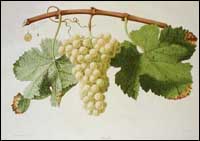 Semillon Semillon
Synonyms
In Australia also known as Hunter
River Riesling. In France also
known as Gros Semillon or Semillon
Muscat.
History
Semillon seems to have originated
in the Bordeaux region of South
West France, where it was certainly
well recognised in the eighteenth
century.
In Australia the variety was
probably brought out in the Busby
collection of 1832. It is known
that wine was being made from
Semillon grapes in the Hunter
Valley area of New South Wales
in the early 1840s.
Geographical distribution
Semillon is the major white
grape of the Gironde region of
South West France, often blended
with other white varieties and
featuring in the world-famous
botrytised sweet wines of Sauternes
and Barsac and the usually dry
white wines of Graves. It is
also grown in Chile, Argentina,
the U.S.A. - especially California-
and Australia.
In Australia the most important
plantings are to be found in
the Hunter Valley and the Murrumbidgee
Irrigation Area of New South
Wales and in the Barossa Valley
and Clare regions of South Australia.
Characteristics
Vine
The vine is a vigorous grower with large, broad, thick 3-5-lobed
dark green leaves, rough on the upper surface and hairy on the
underside.
Fruit
The bunches are compact, winged, medium-sized and cylindrical in
shape. The berries are usually round, thin-skinned, very juicy
and sweet with a distinct varietal flavour. When overripe and
allowed to become affected by botrytis cinerea (noble rot) the
variety is the major component of the unique wines of Sauternes.
Wine
The Semillon grape is distinctive in that it lends itself to the
production of a variety of different wine styles. From the Bordeaux
region of France come the great Sauternes and Barsac. These wines
are produced from overripe Semillon grapes which have been affected
by botrytis cinerea and are hand-picked as ready. When blended
with smaller quantities of Sauvignon Blanc and Muscadelle the
wine produced is viscous with a rich, fruity nose, a smooth,
full-bodied, long lasting and fruity — often citrus-like — palate.
When the grape is unaffected by the botrytis cinerea the juice
is used to make dry white wood-fermented wines with a distinct
palate such as the wine of Graves, also from the Bordeaux area.
In Australia the wine produced
from Semillon grapes presents
different characteristics depending
on the climatic and soil variations
and the winemaker’s style.
From the cool regions the wine
will be high in acid, dry and
often citrus-flavoured on the
palate, whilst wine from the
warmer regions will be less acid,
with less citrus and more tropical
fruit flavours. It may have been
aged in the bottle or wood, adapting
itself to either process. The
Hunter Valley region of New South
Wales is particularly well-known
for its bottle-aged Semillon,
with the wine developing a deep
golden colour and flavours of
honey and toast in a full-bodied,
longlasting palate. In addition
a sweet, full-flavoured and often
viscous wine is produced especially
when the fruit is affected by
botrytis cinerea.
Observations
In Australia Semillon is popular
as a varietal wine, but is often
also blended with Sauvignon Blanc
or Chardonnay.
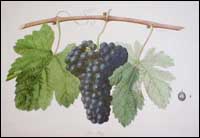 Shiraz Shiraz
Synonyms
In Australia also known as Hermitage,
in France as Syrah or Petite
Syrah.
History
This grape variety seems to
have originated in the Northern
part of the Rhône Valley
in France. It has been known
there since the twelfth century.
Shiraz arrived in Australia in
the Busby Collection of 1832
and features as a variety recommended
for Australian conditions in
Sir William Macarthur’s "Letters
on the Culture of the Vine" published
in 1844 and based on his own
research and experience.
Geographical distribution
Shiraz is the grape variety
used in the famous wines of Hermitage,
Crozes and the Côte Rôtie
in the Rhône Valley of
Eastern France and is also one
of the varieties used in the
wines of Châteauneuf-du-Pape.
It is now also successfully grown
elsewhere especially in Argentina
and Australia.
In Australia, Shiraz is widely
grown but the most significant
regions of production are to
be found in South Australia,
in Coonawarra, the Barossa Valley,
McLaren Vale and the Clare Valley,
in New South Wales especially
in the Lower Hunter Valley, and
in Victoria at Rutherglen and
in the Central Highlands region.
Characteristics
Vine
The vine has a vigorous, spreading growth producing large 5-lobed
leaves with down on the paler green under surface and protuberant
light-yellow veins.
Fruit
The bunches are long, cylindrical in shape and become loose in
structure as the grapes ripen and shrivel. The berry is small
to medium in size, oval in shape, dark black, comparatively thin-skinned,
juicy and sweet.
Wine
The bouquet is usually distinguished by aromas of black pepper,
mulberries and blackcurrants sometimes accompanied by a hint
of tar. These are usually present in the palate together with
hints of tannin and wood — especially American oak in Australia — and
will blend to present a balanced and rich palate with long maturation.
The level of acidity present, the richness of palate and fruit
quality on the palate will vary according to the climatic conditions
of the region of provenance.
Observations
As palate preferences change,
so have many Australian winemakers
chosen to produce a wine from
Shiraz grapes that is now lighter
in style and achieves a balance
between the tannins, wood and
fruit more quickly and have minimalised
the tarry components. In Australia
too it is common practice among
the larger, commercial wineries
to combine Shiraz juice from
the same vintage but from different
vineyards and indeed from different
states and climatic regions in
order to produce a balanced wine.
Shiraz juice is often blended
with Cabernet and also less well-known
varieties e.g. Mourvèdre
and Grenache in Australia. It
is also used to produce a sparkling
red wine, a style currently popular
in Australia, and also excellent
port-style fortified wines.
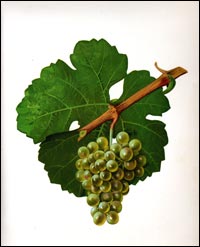 Syilvaner Syilvaner
Synonyms
Also known as Siylvaner. No
other synonyms in Australia.
Elsewhere the variety is known
as Sylvaner vert or Gentil vert
in France, as Grüner Sylvaner,
Grünfraenkisch, Franken
Riesling (in France, Alsace,
Germany), and many others in
Central Europe, differing in
each region.
History
Siyllvaner probably originated
in Austria, though originally
it wass thought to come from
Transylvania. The vine was then
taken into Germany where it is
recorded in medieval times at
Castell in Franken. In Australia
there were experimental plantings
in N.E. Victoria and Eden Valley
in South Australia in the 1970s.….
Imported into Australia. Brown
Bros of N.E. Victoria known to
have experimented with it in
the 1970s - anything else?
Geographical distribution
Silvaner Sylvaner is still to
be found throughout Central Europe,
in Germany and Alsace, France,
although plantings have decreased
considerably. There are now small
plantings in California and Australia.
Characteristics
Vine
The vine is fairly upright, vigorous, productive and a reliable
early ripener.
The leaves are of medium size,
3-lobed, thick, round, with a
light yellowish green upper surface
and a green, hairless under surface.
Fruit
The bunches are small, short, cylindrical and tight. The berries
are of medium size, round unless deformed by pressure, green
with brown sunspots where exposed to the sun and with quite thick
skins.
Wine
The juice is quite thick, viscous with a high natural acidity,
and very sweet and pleasant, but while possessing body, lacks
a distinctive varietal palate. It is therefore usually blended
with the juice of a drier variety e.g. Riesling or Elbling. It
is however sometimes presented as a late harvest sweet wine.
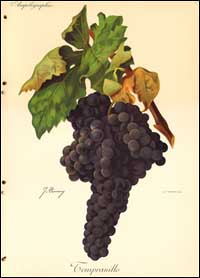 Tempranillo Tempranillo
Synonyms
None in Australia. The variety
is also known in Spain as Tinto
Madrid, Tinto de la Riojga, Tintao
Fino, Tinto del Pais and Tinto
de Toro, in Portugal as Tintao
Roriz or Aragonêz, in California
as Valdepenas and in Italy as
(probably) Negretto.
History
Tempranillo seems to have originated
in Northern Spain and was only
introduced to other countries
in the second half of the twentieth
century. It was officially authorised
in France in 1976, there were
large plantings to be found in
Argentina by 1986 and small plantings
in Australia.
Geographical distribution
Tempranillo is to be found in
Northern and Central Spain especially
in the Rioja Alta and Rioja Alavea,
in Portugal in Aleutejo and Douro,
where it is used predominantly
in the production of port, and
in France in the Midi/Aude region.
It is widely grown in Argentina,
represented in California as
Valdepenas and there are experimental
plantings in Australia.
Characteristics
Vine
The vine is relatively vigorous, upright and drought-resistant
with early-ripening fruit. The leaves are dark green, large,
thick and 5-lobed with a smooth upper surface and a downy lower
surface.
Fruit
The bunches are large, winged, cylindrical and comparatively long.
The berries vary in size but are generally medium-sized, thick
skinned, covered in bloom and juicy.
Wine
Tempranillo provides a deeply coloured, dry, long-lasting wine
with low levels of acid and alcohol. The palate does not have
a marked varietal character and the juice is therefore often
blended with Grenache,Garnacha, Mazuelo, Graciano and more recently
Cabernet Sauvignon and Merlot.
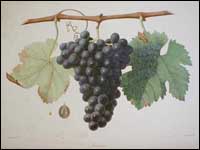 Terret
noir Terret
noir
Synonyms
None in Australia, but also
known as Tarret or Terrain in
South-Eastern France.
History
Terret Noir iTerret noir is
a very old variety and probably
originated in Hérault
in South-Eastern France.
The variety was introduced into
Australia in the Busby collection
of 1832 but is not widely grown.
Geographical distribution
Terret Noir is grown principally
in the Aude, Hérault,
Gard and Vaucluse wine growing
regions of South-Eastern France,
with some plantings in the Minervois
region of South-Westerern France.
However it has decreased in popularity.
In Australia small plantings
are to be found in the Barossa
Valley of South Australia.
Characteristics
Vine
The vine is vigorous, upright in growth and usually yields well.
The leaves are of medium size with 3-5 lobes, with a smooth medium
green upper surface but with a whitish, tufted under surface.
Fruit
The generally medium-sized bunches are pyramid-shaped and usually
compact and winged. The oval berries of medium size have a thick,
firm skin and are transparent, juicy and reddish-black in colour.
Wine
Terret Noir provides a light, fresh, coloured, acidic, astringent
and strongly perfumed wine which blends well with other varieties.
It is one of the varieties recognised officially for inclusion
in the wines of Châteauneuf -du - Pape —du-Pape and
the Côtes du Rhône of South-Eastern France.
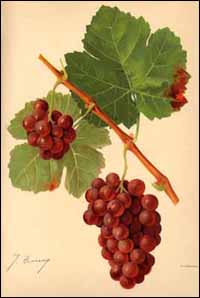 Traminer
(Gewurztraminer) Traminer
(Gewurztraminer)
Synonyms
In Australia the variety is
also known as Gewürztraminer.
In France it is known in Alsace
as Gentil Blanc, Weiss Edler
and Knipperlé or Kniperlé and
it is known as Kleiner Rauschling
in Haut and Bas Rhin and also
as Weiss Klavner in Bas Rhin.
The prefix Gewürz- is often
added to Traminer to describe
a clone producing a more aromatic,
finer and more delicate juice.
History
The variety is thought to have
originated near Tramin in Northern
Italy and been common in the
Alto Adige region in medieval
times, but is usually associated
with the Baden region of Germany
from where plantings spread through
Southern Germany along the Rhine
and Moselle rivers and into Alsace,
where it was recorded in the
late eighteenth century. The
variety was introduced into Australia
in the James Busby collection
of 1832 but has been reintroduced
for more recent plantings.
Geographical distribution
Traminer is to be found in Central
Europe, in Germany especially
in the regions of Baden and the
Rheinpfalz, in France especially
in Alsace, in Italy, Austria,
the United States especially
California, New Zealand and Australia.
In Australia the variety is not
widely grown but the most significant
plantings are probably in South
Australia.
Characteristics
Vine
The vine is vigorous when young, with the size of the 3-5 lobed
leaf depending on whether the vine is planted in a cool or a
warm region.The leaves are rough with a lighter-coloured under
surface which is downy and lightly-veined.
Fruit
The bunches are small, compactness and shape depending on climatic
variations. The berries are small, oval with pink tones when
mature with sun exposure, thick-skinned, crisp, very sweet and
early ripening. The fruit yield is often low and may be erratic.
Wine
The juice from Gewürztraminer grown in a cool climate produces
a deeply-coloured wine with a bouquet which is perfumed, spicy,
floral and yet fruity,with high acid and alcohol levels and a dry
palate which suggests lychees and which should be drunk when young.
In a warm climate, as in Australia, there may be problems with
low acid content and a suggestion of oil on the palate. The Gewürztraminer
wine from Alsace in Northern France is marked by its fruity, grapey
but dry palate and in exceptional years an outstanding wine harvested
late in the season with longliving qualities and a very high alcohol
content is produced, known as Vendange Tardive and later and greater
still Sélection de Grains Nobles. In Australia Traminer
is often blended with Riesling to produce a popular Traminer-Riesling
wine.
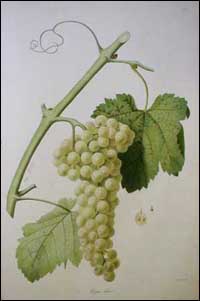 Ugni
blanc or trebbiano Ugni
blanc or trebbiano
Synonyms
In Australia also known as White
Shiraz and White Hermitage. In
France Ugni Blanc or Uni Blanc
has many synonyms in many small
regions and is known as Bouan
or Beau near the Italian frontier,
Cadillac in the Gironde, St Emilion
in Cognac, Trebbiano in Corsica
and as Thalia in Portugal. In
Italy Trebbiano may be followed
by Fiorentino, Toscano etc. to
identify differing but basically
similar sub-varieties.
History
Ugni Blanc may have originated
in the Levant and has been in
Italy since Roman times. One
major strain was certainly recognised
in the thirteenth century near
Bologna, but sub-varieties are
to be found throughout Italy.
It seems that Ugni Blanc was
introduced into Southern France
through the ports such as Marseilles
and Bordeaux, or by the Papal
retreat to Avignon in the fourteenth
century. The variety was introduced
into Australia by James Busby
in 1832.
Geographical distribution
Ugni Blanc is to be found throughout
Italy in various sub-varietal
forms. In France it is to be
found along the Provençal
coast, in the Gironde and Charente.
The variety is also to be found
in South Africa, the U.S.A.-
especially in California - in
Argentina and Australia. The
major plantings in Australia
are in New South Wales and South
Australia.
Characteristics
Vine
The vine is vigorous in growth, quite upright, late budding and
is a very high-yielding variety. The leaves are light green with
tinges of yellow, medium to large depending on the sub-variety,
usually 5-lobed, thick and quite rough with light down on the
under-surface.
Fruit
The bunches are very long, cylindrical and sometimes winged and
forked at the base. The berries are round, transparent, yellow-pink
through to gold in colour with a light bloom. They have tough
skins and tender flesh, yielding large quantities of yellow juice
with an undistinguished nose and rather neutral palate with a
high acid level.
Wine
In Italy new methods are leading to the production of a dry, fresh,
varietal white wine with a low level of alcohol. However the
juice from Ugni Blanc is more often blended with that of other
white varieties such as Malvasia to produce white wines, or most
often added to the juice of red grapes as in the production of
many Chiantis. In France Ugni Blanc is generally blended with
other varieties e.g. Clairette and/or Pascal Blanc in the white
wines of Provence or with Sémillon in the Gironde. Furthermore
up to 20% may be blended into the red wines of the area, especially
those made from Mourvèdre and Petit Bouschet, to add to
the body, finesse and keeping qualities of the wine. In Charente
where the grape is commonly known as St Emilion, it is of particular
importance as it is used in the manufacture of eau de vie as
in the famous brandies of Cognac and, to the South, Armagnac.
In Australia the variety is
similarly used in the production
of brandy or blended with other
white varieties, and only rarely
does it feature as a varietal
wine.
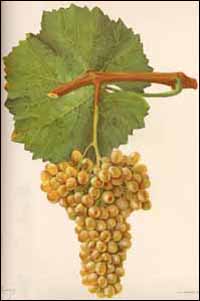 Verdelho Verdelho
Synonyms
In Australia sometimes called
Madeira in New South Wales. In
Portugal also known as Gouveio
or Vidonia.
History
Verdelho is thought to have
originated in Sicily and been
introduced into Madeira possibly
in the fifteenth century. From
there it was probably introduced
into the Douro Valley of Portugal
and then to the Anjou region
and the Loire Valley of Western
France. Verdelho was imported
into Australia in 1825 by the
Australian Agricultural Company
and plantings were established
in New South Wales. By the 1850s
in South Australia, Joseph Gilbert
was growing Verdelho in the Barossa
Valley, John Reynell in McLaren
Vale and Frank Potts at Langhorne
Creek.
Geographical distribution
Verdelho is the dominant white
grape of Madeira. It is found
also in the Douro Valley of Portugal
and the Loire Valley of Western
France. In Australia there are
plantings in New South Wales,
South Australia and Western Australia,
with the wines from Western Australia
being particularly respected.
Characteristics
Vine
The vine is moderately vigorous with a high yield. The leaves are
of medium size, roundish, often 3-lobed, with a matt upper surface
and with hairs on the lower surface.
Fruit
The bunches are winged, small and loose, made up of small, hard-skinned,
oval berries which become golden in colour just as they ripen,
producing a greeny-yellow sweet juice.
Wine
The characteristics and richness of wine produced from Verdelho
grapes will vary according to the climatic and growing conditions
and the wine-making techniques used. The wine is usually aromatic,
coloured, high in alcohol with a palate which can be rich, herbaceous,
spicy and nutty with tropical fruit flavours.
In Portugal Verdelho is used
to produce fortified wines and
it is a major component in the
famous wines of Madeira. In France
a dry white wine is produced.
In Australia the rich, fruity
but dry varietal wine is popular,
particularly that from Western
Australia. In the other states,
Verdelho is more often blended
to produce a longer-living wine
and it is also used to produce
fortified wine.
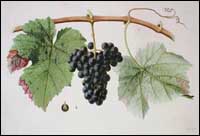 Verdot
/ Petit Verdot Verdot
/ Petit Verdot
Synonyms
None in Australia. In France
Verdot is also known as Pienc,
Fer Servadou, Petit Verdou or
Carmelin. It is not to be confused
with the similar but poorer quality
Gros Verdot.
History
Verdot has its origins on the
right bank of the Garonne in
South-Western France and is mentioned
in eighteenth century French
documents. Verdot was introduced
into Australia by James Busby
in his 1832 collection and Sir
William Macarthur also trialled
the variety in the 1840s.
Geographical distribution
Plantings of Verdot are to be
found in South-Western France,
especially in the Médoc
area. There are also plantings
in Argentina, Chile and Australia.
In Australia there are several
widely scattered small plantings
of the variety.
Characteristics
Vine
The vine is quite vigorous but its yield can be inconsistent depending
on the season. The leaves are long, fine, 3-5 lobed with a distinctive
elongated central lobe and with a dark green, uneven upper surface
and a paler, cottony lower surface.
Fruit
The bunches are below average size, cylindrical, long, winged and
loose. The berries are small, round, dark reddish-black with
thick skins and are late-ripening.
Wine
Verdot produces a slow-maturing, long-living red wine with depth
of colour, tannin, acid and an interesting, often spicy, fragrant
bouquet. It has been an important constituent of many of the
great wines of the Médoc in South-Western France. Verdot
is similarly used in Australia to produce Bordeaux —styletyle
red wines and is also presented as a varietal wine.
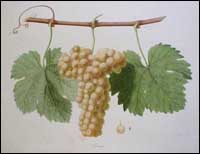 Viognier Viognier
Synonyms
None in Australia. Also known
in France as Vionnier, Viogné and
Petit Vionnier.
History
Viognier is known to have been
present since Roman times in
the Rhône area of South-Eastern
France. In Australia the variety
was imported by the CSIRO from
Montpellier and the first commercial
planting was made by Yalumba
Wines of the Barossa Valley in
South Australia in 1980.
Geographical distribution
Viognier is not widely planted
but is known principally as the
variety used in the famous white
wines of the Condrieu region
and Château Grillet in
the Northern Rhône Valley
of Eastern France and for its
contribution to the red wine
of the Côte Rôtie,
though there are recent plantings
in the Languedoc-Roussillon region
of Southern France. Very small
plantings of Viognier are also
to be found in the U.S.A.- especially
California - and in Australia
in the cooler areas of Victoria
and South Australia.
Characteristics
Vine
The vine is moderately vigorous in growth, producing leaves which
are usually 5-lobed with a matt light-green upper surface and
a lower surface similar in colour but with hairs on the veins.
It is known for its unpredictability.
Fruit
The bunch is medium-sized and winged, cylindrical in shape and
compact. The berries are small, oval, transparent, soft-skinned
and golden on maturity, late-ripening, juicy and very sweet.
Wine
In France the Viognier grape is used to produce the varietal white
wines of Condrieu and in particular Château Grillet. These
wines, of very limited production, are rich, full-bodied, golden
in colour with a dry, long-lasting, spicy, fruity palate reminiscent
of apricots and oranges with floral overtones, but not usually
considered to be long-living wines. Viognier juice is also used
in the red wines of the Rhône Valley especially those from
the Côte Rôtie, the Côte Brune and the Côte
Blonde, where varying percentages of Viognier are added to Shiraz
to give lightness, delicacy and perfume.
In Australia small quantities
of Viognier are produced providing
a dry, fruity white wine with
a smooth citrusy herbaceous palate.
It is also blended with juice
from Marsanne and Roussanne grapes
to produce a Rhône-style
white wine and with Shiraz to
make a red wine..
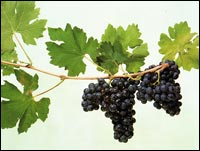 Zinfandel Zinfandel
Synonyms
None in Australia. It is probably
the Primitivo/Primativo of Italy,
also known as Taranto, and the
Plavac Veliki of Yugoslavia and
Dalmatia.
History
Zinfandel probably entered the
USA in the 1800s through the
Eastern States and had arrived
in San Jose, California, by 1859.
It is probable that Zinfandel
and Primitivo are in fact two
clones of the same grape variety
and Plavac Veliki a variety derived
from Zinfandel and Dobricic and
known also as Crljenak. However,
Primitivo has been recognized
as a variety in the Puglio (Apulia)
region of south-eastern Italy
for over possibly 200 years.
Geographical distribution
Zinfandel is the second most
planted red grape in California.
In Italy Primitivo or Taranto
is grown particularly in Southern
Italy in Apulia and is still
to be found in Yugoslavia and
Dalmatia. In Australia, small
plantings are mainly to be found
in Western Australia and the
MclarenSouthern Vales area of
South Australia.
Characteristics
Vine
The best quality grapes are produced from mature low-yielding vines.
The vines are fairly vigorous and benefit from a climate which
ranges from cool to hot but do not cope well with excessive heat.
Fruit
The bunches need careful treatment as the fruit can ripen unevenly
and also shrivel in heat. Harvesting usually takes place comparatively
early, but it may in particularly suitable seasons be late-harvested.
Wine
Zinfandel produces a juice that may have high levels of alcohol
and sugar, is well coloured and variously coloured, and has marked
varietal characteristics. The quality and palate of the wine
produced varies considerably according to the microclimate, altitude,
time chosen for harvesting , the skills of the winemaker and
the market to which the finished product is directed.
References
VIALA, Pierre and VERMOREL,Victor.
Traite général
de viticulture. Ampélographie.
Vols.1-V11. Masson. Paris. 1901-1910.
RENDU, Victor. Ampélographie
française. 2nd.
ed. Masson. Paris. 1857.
COSTA, B.C.Cincinnato da. Portugal
Vinicola. Imprensa Nacional.
1900.
MORTON, Lucie.T.,(trans) and
GALET,Pierre. A Practical Ampelography.
Comstock/Cornell University Press.
1979.
MARES, Henri. Description des
cépages principaux de
la région Mediterraneénne
de la France. Coulet. Montpellier.
Masson. Paris. 1890.
DION, Roger. Histoire de la
vigne et du vin en France. Sevin.
Paris.1957.
BUSBY, James. Journal of a tour.
Stephens and Stokes. Sydney.
1833.
MACARTHUR, W.M. (MARO). Letters
on the culture of the vine. Statham
and Forster. Sydney. 1844.
KERRIDGE, G. and ANTCLIFF, A.
Wine grape varieties. Rev. ed.
CSIRO. 1999.
ANTCLIFF, A.J. Major wine grape
varieties of Australia. CSIRO.
1979.
BEESTON, John. Varietal Wines
of Australia. Angus and Robertson/
Harper Collins. N.S.W. 1991.
BEESTON, John. A Concise History
of Australian Wine. 2nd.
ed. Allen and Unwin. N.S.W. 1995.
ROBINSON, Jancis. Vines, Grapes,
Wines. Knopf. New York. 1986.
ILAND, Patrick and GAGO, Peter.
Australian Wine from the vine
to the glass. Patrick Iland Wine
Promotions. Adelaide, South Australia.
1997.
BOEHM, E.W. and TULLOCH, H.W.
Grape Varieties of South Australia.
Dept. of Agriculture, South Australia.
Adelaide. 1967.
SUTHERLAND, George. The South
Australian Vinegrowers Manual.
Bristow, Government Printer.
Adelaide. 1892.
KELLY, A.C. Wine Growing in
Australia. E.S.Wigg. Adelaide.
1867.
McKAY, A.D., CRITTENDEN,G.,
DRY, P.R. and HARDY, W.J. Italian
Winegrape Varieties in Australia.
Winetitles. South Australia.
1999.
RENOUIL,Y. and TRAVERSAY, P.de
. Dictionnaire du vin. Feret
et fils. Bordeaux. 1962.
RANKINE, Bryce. Tasting and
Enjoying Wine. Winetitles. Adelaide.
1990.
LAKE, Max. The Flavour of Wine.
Jacaranda Press. 1969.
Australian and New Zealand Wine
Industry Directory. 18th.
Annual ed. 2000. Australian Industrial
Publications. Adelaide.
BULLEID, N. Alternative white
varieties. Australian and New
Zealand Wine Industry Journal.
Vol 13.
No.3.(Aug. 1998.). Winetitles.
Adelaide. |


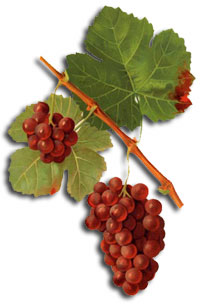


 Barbera
Barbera Cabernet
franc
Cabernet
franc Cabernet
sauvignon
Cabernet
sauvignon Carignan
Carignan Chardonnay
Chardonnay Chasselas
Chasselas Chenin
blanc
Chenin
blanc Dolcetto
Dolcetto Durif
Durif Furmint
Furmint Gamay
Gamay Grenache
Grenache Malbec
or cot
Malbec
or cot Marsanne
Marsanne Merlot
Merlot Mourvedre
Mourvedre Muscat
de frontignan
Muscat
de frontignan Palomino
Palomino Pedro
ximenez
Pedro
ximenez Pinot
gris
Pinot
gris Pinot
noir
Pinot
noir Riesling
Riesling Roussanne
Roussanne Sauvignon
blanc
Sauvignon
blanc Semillon
Semillon Shiraz
Shiraz Syilvaner
Syilvaner Tempranillo
Tempranillo Terret
noir
Terret
noir Traminer
(Gewurztraminer)
Traminer
(Gewurztraminer)  Ugni
blanc or trebbiano
Ugni
blanc or trebbiano Verdelho
Verdelho Verdot
/ Petit Verdot
Verdot
/ Petit Verdot Viognier
Viognier Zinfandel
Zinfandel